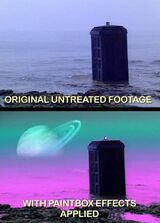Template:Aotm/24: Difference between revisions
(Created page with "left|160px The '''Quantel Paintbox''', more usually just called "Paintbox", was an early computer graphics workstation that revolutionised the way televisio...") |
Josiah Rowe (talk | contribs) m (typo) |
||
| Line 1: | Line 1: | ||
[[file:Paintbox.jpg|left|160px]] | [[file:Paintbox.jpg|left|160px]] | ||
The '''Quantel Paintbox''', more usually just called "Paintbox", was an early computer graphics workstation that revolutionised the way television graphics were produced in the [[1980s]]. Like many other [[visual effects]] seen on early ''[[Doctor Who]]'' — such as [[colour separation overlay]], Paintbox primarily had applications in sports and news programming, but was used more creatively by the [[visual effects designer]]s of ''[[Doctor Who]]''. Although Painbox was primarily just for adding textual elements to pictures, the ''Doctor Who'' crew ambitiously used it for [[colourist|colour grading]] and for the insertion of simple graphical elements. Though its first use was in the [[Fourth Doctor]] story, ''[[The Leisure Hive (TV story)|The Leisure Hive]]'', it was perhaps more noticeably used during the [[Sixth Doctor|Sixth]] and [[Seventh Doctor]]'s eras, particularly to give a more "alien ambience" to certain shots. Perhaps its most | The '''Quantel Paintbox''', more usually just called "Paintbox", was an early computer graphics workstation that revolutionised the way television graphics were produced in the [[1980s]]. Like many other [[visual effects]] seen on early ''[[Doctor Who]]'' — such as [[colour separation overlay]], Paintbox primarily had applications in sports and news programming, but was used more creatively by the [[visual effects designer]]s of ''[[Doctor Who]]''. Although Painbox was primarily just for adding textual elements to pictures, the ''Doctor Who'' crew ambitiously used it for [[colourist|colour grading]] and for the insertion of simple graphical elements. Though its first use was in the [[Fourth Doctor]] story, ''[[The Leisure Hive (TV story)|The Leisure Hive]]'', it was perhaps more noticeably used during the [[Sixth Doctor|Sixth]] and [[Seventh Doctor]]'s eras, particularly to give a more "alien ambience" to certain shots. Perhaps its most obvious applications were in the stories ''[[Mindwarp (TV story)|Mindwarp]]'' (pictured), ''[[Time and the Rani (TV story)|Time and the Rani]]'' and ''[[Survival (TV story)|Survival]]''. '''''[[Quantel Paintbox|Read more...]]'''''<noinclude>[[category:aotm templates]]</noinclude> | ||
Revision as of 06:16, 13 June 2012
The Quantel Paintbox, more usually just called "Paintbox", was an early computer graphics workstation that revolutionised the way television graphics were produced in the 1980s. Like many other visual effects seen on early Doctor Who — such as colour separation overlay, Paintbox primarily had applications in sports and news programming, but was used more creatively by the visual effects designers of Doctor Who. Although Painbox was primarily just for adding textual elements to pictures, the Doctor Who crew ambitiously used it for colour grading and for the insertion of simple graphical elements. Though its first use was in the Fourth Doctor story, The Leisure Hive, it was perhaps more noticeably used during the Sixth and Seventh Doctor's eras, particularly to give a more "alien ambience" to certain shots. Perhaps its most obvious applications were in the stories Mindwarp (pictured), Time and the Rani and Survival. Read more...

